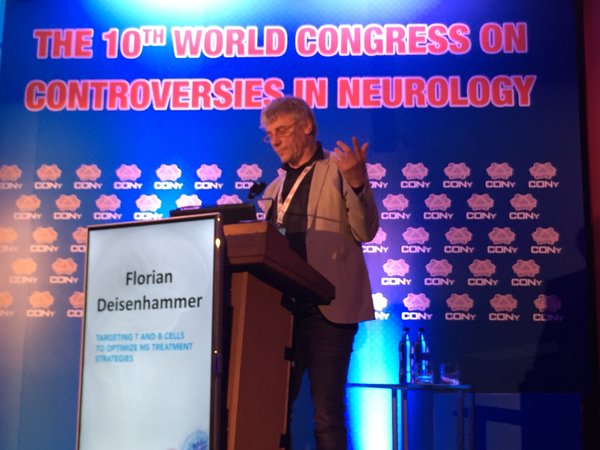CONy16: Sanofi Genzyme Symposium on MS Therapies Targeting T and B Cells; Exclusive Interview with Lead Researcher

Sanofi Genzyme, one of the companies participating in the four-day 10th World Congress on Controversies in Neurology (CONy) in Lisbon, Portugal, that concluded on March 20, 2016, supported several symposiums focused on multiple sclerosis (MS) — including one on B-cell and T-cell therapies.
For over a decade, Sanofi Genzyme has worked to develop effective therapies for MS. The company has two MS drugs approved by the U.S. Food and Drug Administration (FDA): Lemtrada (alemtuzumab) and Aubagio (teriflunomide).
Lemtrada is a humanized monoclonal antibody against specific receptors (CD52 proteins) on the surface of immune cells (B and T cells). The drug can modulate the defective immune response that contributes to MS. Aubagio is an active metabolite of the compound leflunomide and a pyrimidine synthesis inhibitor. It has immunomodulatory and anti-inflammatory properties, and is thought to be able to reduce the number of activated lymphocytes (important immune cells like B and T cells) that enter the central nervous system and contribute to MS pathology.
Both Lemtrada and Aubagio can reduce MS relapse rates and delay disease progression. Aubagio has also been shown to slow the loss of brain volume (or atrophy).
In one of the Sanofi Genzyme-supported symposiums, titled “Targeting T and B Cells to Optimize MS Treatment Strategies,” chaired by Lívia Sousa, expert Neurologist at Centro Hospitalar e Universitário de Coimbra, Portugal, Florian Deisenhammer, a professor of Neurology at Innsbruck Medical University, Austria, presented the talk, “T and B Cells in MS Immunopathology, What’s one without the other?”
Professor Deisenhammer explained that while many immune cell types contribute to MS pathophysiology, B and T cells are especially notable through the regulation of inflammatory responses and the induction of factors that lead to neuronal injury.
The “balance of T-cell subtypes and responses is skewed in MS,” he said. “CD8 killer T cells can directly destroy axons, [while] B cells can contribute to the pathogenesis of MS through cytokine production, antigen presentation, and formation of autoantibodies.”
According to Professor Deisenhammer, it is the interaction between B and T cells that drives MS pathophysiology, and therefore “upstream targeting of both cells types directly is a rational therapeutic approach.” This can be achieved through several methods, including “targeting activated lymphocyte proliferation, targeting lymphocytes by selective depletion, and interfering with lymphocyte trafficking,” he concluded.
Professor Xavier Montalban from the Vall d’Hebron University Hospital in Barcelona, Spain, and Professor Dimos-Dimitrios Mitsikostas from the Athens Naval Hospital, Greece, together gave a presentation titled “What is the Goal for Clinical Decision Making in MS?”
Professor Montalban discussed data from large Phase 3 clinical trials testing the safety and efficacy of Aubagio (teriflunomide) in MS, namely the TEMSO and TOWER trials. The trials showed that the drug significantly reduced the annualized relapse rate in MS patients, especially in those who had previously used more than one disease-modifying therapy (DMT).
He emphasized the importance of assessing brain atrophy rates in MS patients, and noted that Aubagio was found to “reduce the loss of white matter volume, but not whole brain volume in the TEMSO trial.”
In terms of safety,”serious adverse events were similar in placebo and teriflunomide” groups, he said, as well as the incidence of serious infections. The mean neutrophil and lymphocyte also counts remained within normal range in patients receiving Aubagio. Furthermore, treatment with Aubagio had no implications in pregnancy, Professor Montalban reported.
Professor Mitsikostas discussed data from Phase 3 clinical trials on Lemtrada (alemtuzumab) — namely, the CARE-MS I and CARE-MS II studies.
“In patients who received Alemtuzumab 12 mg during the CARE-MS core studies, relapse rates remained consistently low through the first the years of the extension,” he said. “Eighty-five percent of the patients at year five were relapse free. … Most patients had improved or stable EDSS [expanded disability status scale] score from core study baseline through year four.” EDSS is a score reflecting the degree of disability. Furthermore, the slowing of brain volume loss in patients treated with alemtuzumab was maintained through five years.
Concerning safety, Professor Mitsikostas reported that “autoimmune thyroid disorders were observed in 39 percent of patients over five years,” but that “thyroid adverse events did not negatively impact quality of life.” He also mentioned that the incidence of infusion-associated reactions (IARs) with alemtuzumab, and the overall infection rate, decreased over time.
Professor Mitsikostas concluded his presentation by asking, “What do MS patients prefer in a DMT? What matters more?” According to him, MS patients are particularly concerned with the frequency of administration of a given treatment, the route of administration, and the frequency of side effects.
Multiple Sclerosis News Today had the opportunity to conduct an exclusive interview with Professor Deisenhammer.
In the interview, he was asked if therapies that reset the defective immune system might be key to a potential cure. He responded: “The Lemtrada data, as has been just shown in five years, is very impressive. Many patients stay quite stable for a relatively long time, so that is definitively attractive. The mechanism needs to be elucidated a bit further, but … the idea is that if we deplete the B and T cells almost fully, and then have probably a repopulation of slightly different cells, that might be a part of the [positive] effect.” And he added, “then with Aubagio, … you target a similar cell population, but it has a little less aggressiveness. Let’s put it like this … you get a reduction of active cells, but the housekeeping cells are still there.”
The complete interview with Professor Deisenhammer can be accessed through this link, or viewed below.






